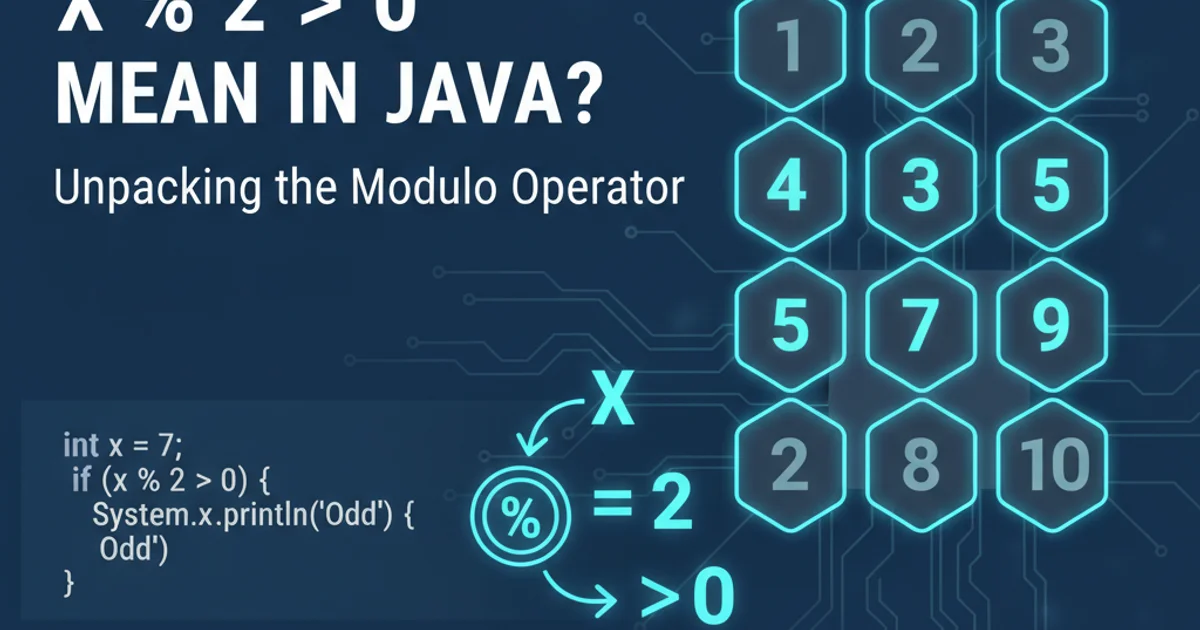what does x % 2 > 0 mean in java?
Categories:
Understanding x % 2 > 0 in Java: Odd or Even?

Explore the meaning and common uses of the modulo operator expression x % 2 > 0 in Java, a fundamental concept for determining odd numbers.
In Java, the expression x % 2 > 0 is a concise way to check if an integer x is an odd number. This seemingly simple line of code leverages the modulo operator (%), a powerful tool for various arithmetic and logical operations. Understanding how it works is crucial for tasks ranging from basic number checks to more complex algorithms involving patterns and divisibility.
The Modulo Operator (%) Explained
The modulo operator (%) in Java returns the remainder of a division operation. For example, 5 % 2 evaluates to 1 because 5 divided by 2 is 2 with a remainder of 1. Similarly, 10 % 3 evaluates to 1 because 10 divided by 3 is 3 with a remainder of 1. When the division is exact, the remainder is 0. For instance, 4 % 2 is 0.
int a = 5;
int remainder1 = a % 2; // remainder1 will be 1
int b = 4;
int remainder2 = b % 2; // remainder2 will be 0
int c = 10;
int remainder3 = c % 3; // remainder3 will be 1
Examples of the modulo operator in Java.
Deconstructing x % 2 > 0
Let's break down the expression x % 2 > 0 step by step:
x % 2: This part calculates the remainder whenxis divided by2.- If
xis an even number (e.g., 2, 4, 6), it is perfectly divisible by 2, so the remainder will be0. - If
xis an odd number (e.g., 1, 3, 5), it is not perfectly divisible by 2, so the remainder will be1.
- If
> 0: This part compares the result ofx % 2with0.- If
x % 2is0(meaningxis even), then0 > 0isfalse. - If
x % 2is1(meaningxis odd), then1 > 0istrue.
- If
Therefore, the entire expression x % 2 > 0 evaluates to true if x is an odd number and false if x is an even number. This is a common idiom for checking parity.
flowchart TD
A[Start: Integer x] --> B{Calculate x % 2}
B --> C{Remainder == 0?}
C -- Yes --> D[x is Even]
C -- No --> E[x is Odd]
D --> F[Result: false]
E --> G[Result: true]
F & G --> H[End]Flowchart illustrating the logic of x % 2 > 0.
public class ParityCheck {
public static void main(String[] args) {
int num1 = 7;
int num2 = 10;
int num3 = -3; // Behavior with negative numbers
if (num1 % 2 > 0) {
System.out.println(num1 + " is an odd number."); // Output: 7 is an odd number.
} else {
System.out.println(num1 + " is an even number.");
}
if (num2 % 2 > 0) {
System.out.println(num2 + " is an odd number.");
} else {
System.out.println(num2 + " is an even number."); // Output: 10 is an even number.
}
// Special consideration for negative numbers
// In Java, -3 % 2 evaluates to -1. So -1 > 0 is false.
// This means for negative numbers, x % 2 != 0 is a better check for oddness.
if (num3 % 2 != 0) {
System.out.println(num3 + " is an odd number (using != 0)."); // Output: -3 is an odd number (using != 0).
} else {
System.out.println(num3 + " is an even number.");
}
if (num3 % 2 > 0) {
System.out.println(num3 + " is an odd number (using > 0)."); // This will NOT print for -3
}
}
}
Practical example of checking odd/even using x % 2 > 0 and x % 2 != 0.
x % 2 > 0 works perfectly for positive integers, for negative integers, x % 2 can return -1 (e.g., -3 % 2 is -1). In such cases, -1 > 0 is false, incorrectly classifying -3 as not odd. A more robust check for oddness that handles both positive and negative numbers is x % 2 != 0.Common Use Cases
This expression is frequently used in various programming scenarios:
- Conditional Logic: Performing different actions based on whether a number is odd or even.
- Looping and Iteration: Processing elements at odd or even indices in an array or list.
- Pattern Generation: Creating alternating patterns, such as coloring rows in a table or grid.
- Algorithm Design: As a building block in more complex algorithms that rely on number properties.
x % n to check if x is divisible by any integer n, or to find patterns that repeat every n elements.